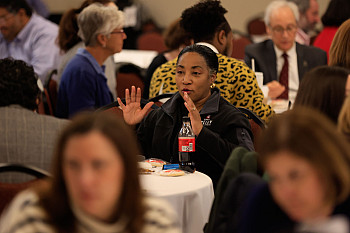Strategic plan committee members discuss excitement, next steps
By IUPUI Today
May 04, 2023
A meeting about IU Indianapolis 2030, held May 2 at the Madam Walker Legacy Center, radiated positivity, as the crowd often broke out into applause, cheering and laughter.

“I think it’s wonderful we all were able to assemble to talk about the future of IU Indianapolis in 2030. It’s exciting,” said NiCole Keith, associate dean of faculty affairs in the School of Health and Human Sciences and member of a Transformative Research and Creativity subcommittee.
The meeting came three weeks after Indiana University President Pamela Whitten announced that the Board of Trustees officially endorsed IU 2030, including the Indianapolis campus’s ambitious goals.
Interim Chancellor Andrew Klein kicked off the event by thanking committee members for their hard work and praising the IU Indianapolis 2030 priorities.

“For example, the plan clearly acknowledges our strong connection to our local community, and our pride in being a place where issues of inclusion and equity are taken seriously and addressed openly.”

Each group brainstormed before sharing their answers with the room. Many of the ideas had similar themes of breaking down so-called silos across schools and units to improve collaboration and integration; building better partnerships with companies and organizations within the community to create opportunities for students; and clarifying branding.
“I’m looking forward to people really understanding what IU Indianapolis is, what we mean to our city and to our state, and what we can do in terms of the advancement of knowledge through both education and research,” Keith said.
“I think the strategic plan gives us a great sense of direction in a time of major change,” said Brian Starkel, associate director of student and family connections in the Division of Student Affairs and a member of a Student Success and Opportunity subcommittee. “I think it allows us to feel anchored in that change and gives us goals to look forward to, as well as opportunities to be really creative and innovative.
“It’s also an opportunity for everybody to get involved, from students to faculty to deans. This is a chance for everybody to understand that there is a plan and everybody can make an impact.”
As the implementation process gets underway, Klein shared a message of confidence.
“I’m really excited to see the same energy and commitment that you brought to creating the plan brought to implementing it,” he said. “We’re going to be successful because of the spirit of people like you.”
The campus and broader communities are encouraged to read the full strategic plan, which includes goals, objectives and metrics for each pillar.